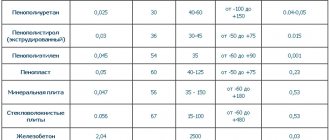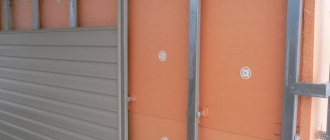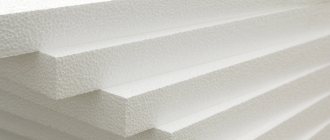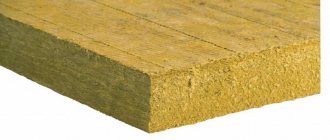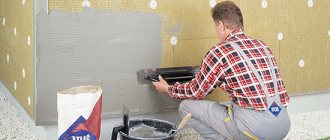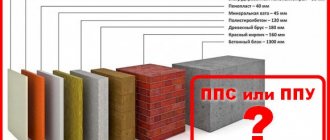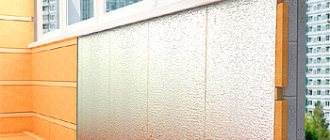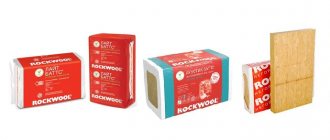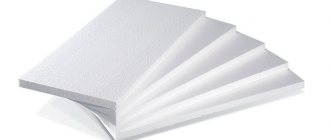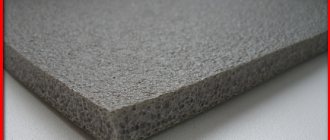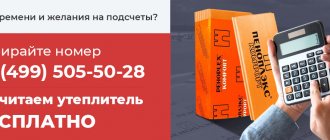Description of material – penoplex
Innovative insulation to create a comfortable atmosphere in the home.
The insulation consists of slabs consisting of sealed small cells, due to which the water absorption rate is almost zero. The material obtains its density and thermal conductivity thanks to a special production method. Expanded polystyrene is used to make boards. The granules are placed in an extruder, where the material foams under the influence of temperature and pressure. It is then passed through dies, which give the heat insulator the shape of slabs. The result is insulation with high technical performance.
Advantages and disadvantages of penoplex
The material has pros and cons, which depend on the properties of the insulation. The insulation gained popularity due to the following qualities:
- Low thermal conductivity. The thermal conductivity coefficient is the lowest among all insulation materials, due to which the thermal insulation material is used in regions with extremely low temperatures.
- Low vapor permeability makes the insulation effective in terms of thermal insulation, while at the same time, an underestimated indicator leads to the formation of condensation, which negatively affects the indoor atmosphere and the quality properties of the material.
- Long service life. Penoplex will last more than 40 years.
- High strength, which makes the boards resistant to mechanical, chemical, and atmospheric influences.
- Easy to install. The slabs are fastened with minimal labor costs. Even an inexperienced person can cope with the insulation procedure.
- Excellent price-quality ratio.
We managed to combine a lot of advantages in one material. At the same time, penoplex also has disadvantages that limit the scope of application of the material. Users highlight the following disadvantages:
- High degree of fire hazard. The category depends on the brand of insulation and varies from G1 to G4. The insulation is highly flammable and can extinguish on its own. The toxicity of the smoke released during combustion is dangerous to human health.
- Poor adhesive properties. The heat insulator does not adhere well to the base, so it is important to use additional fasteners during installation.
- Low degree of resistance to ultraviolet radiation. The sun's rays negatively affect the performance of insulation, so it is important to quickly protect the surface with a finishing layer.
- Attractive to rodents. Most often, pests gnaw on material if it blocks their path to water and food. To solve the problem, use a fine-mesh metal mesh.
- In terms of cost, the material is not the cheapest. It is in the middle price segment. In order to save money, they purchase cheaper options, for example, polystyrene foam.
A detailed description of penoplex allows you to evaluate how rational the use of insulation is for each specific situation, therefore, before thermal insulation, you should carefully study the material passport.
What is penoplex
Characteristics
Let's compare the characteristics of penoplex and expanded polystyrene:
| Options | Penoplex | Expanded polystyrene |
| Thermal conductivity coefficient, W/mºK | 0,03 | 0,036-0,050 |
| Water absorption per day, % of volume | 0,2 | 2 |
| Density, kg/m3 | 28-45 | 15-35 |
| Compressive strength, MPa (10% deformation) | 0,25-0,5 | 0,05-0,2 |
In terms of thermal conductivity and strength, extruded polystyrene foam looks advantageous not only in comparison with polystyrene foam, but also with many other materials, such as mineral wool.
Comparison of thermal conductivity of extruded foam with other materials
As you can see, the technical characteristics of penoplex are higher.
General information
First of all, let's figure out what penoplex is. So, this material is extruded (extruded) polystyrene foam.
It must be said that in our country it is customary to call any extruded polystyrene foam foam. In fact, “Penoplex” is the name of the company that produces this type of insulation in Russia and other CIS countries. Therefore, further we will talk about extruded polystyrene foam from this company.
Let me remind you that extruded polystyrene foam is a polymer insulation that was invented in the middle of the last century. Essentially, this is the same polystyrene foam (foam), but manufactured using a special technology, as a result of which it acquires special qualities. In particular, the following differences from polystyrene foam can be distinguished:
Structure . If polystyrene foam has a granular structure, then penoplex is a more homogeneous cellular material;
- Density _ Extruded polystyrene foam is denser than polystyrene foam;
- Durability . As a result of its higher density and homogeneous structure, this insulation also has higher strength.
Extruded polystyrene foam has a uniform structure and smooth surface
Externally, penoplex is easy to distinguish from polystyrene foam. The latter is white, while penoplex is orange. In addition, extruded polystyrene foam has a smooth surface.
Advantages and disadvantages
Home craftsmen are often interested in what is better penoplex or polystyrene foam? To answer this question, below I will give the positive and negative qualities of penoplex, and compare them with the properties of ordinary polystyrene foam.
Advantages:
- Efficiency. Despite the fact that the insulation in question has a higher density than polystyrene foam, its thermal conductivity is lower, i.e. it holds heat better;
Due to its high strength, extruded foam can be laid under screed
- Durability . This material is able to withstand heavy loads, which expands its scope of application;
- Moisture resistance . The insulation practically does not absorb moisture, in comparison with other materials, for example, polystyrene foam;
Penoplex practically does not absorb moisture
- Fire safety . Refers to low-flammable materials. The exception is brands that are intended for insulating foundations or floors under screed. The flammability of polystyrene foam is almost always very high, since manufacturers do not add fire retardants to it in order to save money;
- Durability . Service life exceeds 50 years. As practice shows, expanded polystyrene becomes unusable earlier;
- Environmentally friendly. At normal temperatures, both materials do not emit harmful substances;
- Chemical resistance. Both materials are resistant to most chemicals. The exception is organic solvents such as white spirit.
Penoplex can last more than 50 years even in adverse operating conditions
Flaws . At first glance, a comparison of materials suggests that penoplex is better than expanded polystyrene. However, like any other insulation, it has its disadvantages:
- High price . Penoplex slabs are several times more expensive than expanded polystyrene;
- Low adhesion . Plaster and adhesive mixtures do not adhere well to this material. True, Penoplex produces special facade slabs that have a rough surface, which improves their adhesion to building mixtures;
- Low vapor permeability . This disadvantage is common to both materials.
Considering these disadvantages, everyone must decide for themselves what is better to use - polystyrene foam or extruded polystyrene foam. For example, to insulate a foundation or basement, it is better to use extruded foam.
Foam plastic has better adhesion than penoplex
If you need to finish the walls of the facade, then it is impossible to say unequivocally what is better - polystyrene foam or polystyrene foam. Considering the low cost of polystyrene foam and its good adhesion, you can give it preference.
Types and scope
So, we found out what is warmer - penoplex or polystyrene foam, and also got acquainted with other characteristics of insulation. But for what purposes is it used?
The Penoplex company produces several brands of extruded polystyrene foam, which have different areas of application. Therefore, next we will look at all the series and find out what the difference between them is.
Penoplex Foundation can withstand heavy mechanical loads
So, currently you can find the following Penoplex slabs on sale:
- Foundation. As you might guess from the name, this series is designed for insulating foundations, blind areas, and plinths. The slabs can also be laid under a screed. The main characteristic of these plates, in addition to thermal conductivity, is high strength. Since fire safety is not important, the composition does not contain a fire retardant. Therefore, it is not recommended to use them in structures that do not have a protective layer;
- Roofing _ This brand is designed specifically for flat roofs. They are lightweight and yet highly durable. The main feature of this brand is that each slab has an L-shaped edge. Thanks to this, no gaps are formed when laying them;
Insulation of the “Comfort” series can be used to insulate balconies
- Comfort. This brand is designed to insulate homes from the inside. The slabs are also suitable for insulating balconies and loggias. In addition to high thermal conductivity, their peculiarity lies in their high environmental friendliness - the insulation does not contain any harmful chemicals;
Plates of the “Pitched Roof” series are designed for roof insulation
- Pitched roof. Plates of this series are designed for insulation of pitched roofs. They have a low density, but are moisture resistant and rigid. The tenons and grooves on the edges eliminate the formation of cold bridges when joining the slabs, and also simplify DIY installation. In addition, they can serve as additional protection against moisture.
- Facade . The peculiarity of these plates is the presence of a corrugated surface. Thanks to this, they can be used to insulate walls using the “wet facade” technology. It must be said that the penoplex insulation of this series is suitable not only for external, but also for internal use;
Despite the presence of texture, before applying the plaster-adhesive mixture, it is advisable to treat the surface of the insulation with an adhesive primer.
Penoplex “Facade” can be used for external insulation of walls using the “wet” method
- Wall . The slabs of this series have a slightly lower density than “Facade”. The manufacturer recommends using them as a filler for frame walls. At the same time, this insulation can be considered as a replacement for the “Facade” series slabs, i.e. it can be used for wet and curtain facades;
Penoplex wall can be used to insulate frame walls
- The basis. This series is the most versatile, since the slabs can be used to insulate walls, floors, roofs and even foundations. The slabs combine excellent thermal insulation properties and the ability to withstand heavy mechanical loads.
“Basis” series slabs can be laid under a slab foundation
It must be said that in addition to the series listed above, which can be classified as household, there are also industrial ones, such as Penoplex 45. They are used in the construction of roads, airfield runways, etc. You will not find such brands in construction stores.
Despite the moisture resistance of penoplex, instructions for its installation in wooden frame structures (walls, roofs and ceilings) require the use of vapor barrier and waterproofing. Otherwise, moisture will accumulate in the wooden structural elements, which will lead to their rotting and other negative consequences.
Types and sizes of thermal insulation boards
Depending on the purpose of using penoplex for home and garden, the most suitable type of material is selected. Types of insulation differ in characteristics and sizes, so it is important to correctly determine the most suitable brand.
The basis
Penoplex Base is suitable for insulating walls and roofs if they are not subject to heavy loads. This type has important qualities: low thermal conductivity and water absorption, high strength, and resistance to rotting. The density of the material depends on the thickness of the slabs. This type is presented in 5 types:
- 2 cm;
- 3 cm;
- 4 cm;
- 5 cm;
- 10 cm.
The dimensions of the slab are as follows: length – 11.85 cm; width – 5.85 cm. Service life is up to 50 years.
Comfort
Using this type, the basement, walls and roof are insulated. Penoplex Comfort slabs are used for thermal insulation of loggias, balconies, greenhouses and utilities. The insulation tolerates temperature changes, is resistant to the formation of mold and mildew, and is easy to install thanks to a special fastening system. The operating temperature range of the TU is from -70 to +75°C. Other characteristics are as follows: compressive strength - 15 MPa, 25 kg/m³ - material density.
Facade
Penoplex Facade is designed for internal and external thermal insulation work.
The surface of the slabs is milled, which improves adhesion to the surface and facilitates the finishing procedure. The material is represented by slabs of various thicknesses. Material density 25-33 kg/m³. Facade insulation can be used to insulate internal walls and partitions, due to its environmental friendliness. There are other types of extruded polystyrene foam. Penoplex, having a density of 35, 45, is more often used for insulation of enclosing structures. It is permissible to insulate structures that are subject to heavy loads. Also common are Geo penoplex, penoplex foundation, penoplex roofing. When choosing a type, all features are taken into account, and attention is also paid to the compliance of the insulation with GOST requirements.
Penoplex wall insulation: selection, price, step-by-step installation instructions
Any residential buildings located in cold regions of the country require mandatory insulation, since walls not insulated from low temperatures are one of the main causes of heat losses, which can amount to up to 25-30%. Penoplex wall insulation is used for both external and internal thermal insulation of buildings.
Penoplex wall insulation
This material has all the necessary performance qualities that will help protect walls not only from winter cold, but also from overheating in the summer heat. Previously, ordinary polystyrene foam was more often used for these purposes. Although it is made from, in principle, the same raw materials as penoplex, the technology is completely different, so the material has a more porous structural structure, which is not entirely suitable for external insulation.
Main characteristics of penoplex
Penoplex is slabs of expanded polystyrene obtained using extrusion technology - forcing foamed molten plastic mass through molding nozzles (nozzles). As a result of the combined influence of temperature and high pressure, upon hardening the material acquires a finely porous structure, with small air “cells” of approximately the same size (from 100 to 200 microns), each of which is isolated from the others. This structure provides two main characteristics of this type of polystyrene foam - excellent insulating qualities along with high mechanical strength.
Thanks to its microporous structure, penoplex has high insulating qualities and mechanical compressive strength.
To begin with, in order to evaluate the advantages of penoplex, here are briefly a few digital indicators of the main parameters of this material.
Table: technical characteristics of penoplex
| Name | Test method | Unit | Numerical indicators |
| Compressive strength at 10% linear deformation, not less | GOST EN 826-2011 | MPa (kgf/cm²; t/m²) | 0.2 |
| Density | GOST 17177-94 | kg/m³ | 25-32 |
| Water absorption in 24 hours, no more | GOST 17177-94 | % by volume | 0.4 |
| Fire resistance category | F3-123 | group | G3 |
| Thermal conductivity coefficient at (25±5) °C | GOST 7076-99 | W/(m×°С) | 0.03 |
| Sound insulation of partition (GKL-PENOPLEX® 50 mm-GKL), Rw | GOST 27296-87 | dB | 41 |
| Standard sizes | Width | mm | 600 |
| Length | mm | 1200 | |
| Thickness | mm | 20; 30; 40; 50; 60; 80; 100; 120; 150 | |
| Operating temperature range | THAT | °C | -100 … +75 |
Even a preliminary assessment of the given characteristics shows that the material is very effective for thermal insulation work. However, it is worth considering its qualities in more detail:
Low water absorption
This parameter is very important for any insulation, since with high hygroscopicity the material swells, loses its air layer, and freezing of the absorbed water can cause its destructuring, causing it to lose its basic qualities and become useless.
The value of this parameter for penoplex was officially determined through laboratory tests. The material was completely immersed in water and then monitored for a month. At the same time, it was revealed that the penoplex absorbed a small amount of moisture only in the first ten days, and then the humidity in it did not increase at all.
After 30 days, the amount of absorbed moisture in the penoplex was about 0.6% of the total volume of the slab. Based on this, it was concluded that moisture penetrates only into the outer layer of the material and at the site of its cut, but does not enter its internal structure.
This indicator is even close to hydrophobicity, which is extremely important for insulation for external use. By the way, the fact that the material is resistant to mold and rot directly depends on this parameter.
Low thermal conductivity
The thermal conductivity of penoplex, the coefficient of which is only 0.03 W/m×°C, is one of the lowest among all insulation materials. This parameter is largely achieved due to the structural structure of penoplex and its low moisture absorption.
Thanks to these qualities, the insulation can be used for installation in rooms with high humidity, such as basements, as well as for installation outside walls and for thermal insulation of building foundations.
The foundation and basement of the house also need insulation!
The durability of a strip foundation directly depends on its protection from the effects of ground moisture and low temperatures. Penoplex is ideal for these purposes.
How to properly waterproof the foundation and insulate the foundation with penoplex - read in the special publications of our portal.
Resistance to mechanical stress
The technology for manufacturing penoplex using the extrusion method gives a highly homogeneous structure of the material and makes it very durable. Penoplex almost does not press through when you press it. There will be no significant changes in the structure of the insulation and when walking on it, since it can withstand heavy loads perfectly. The only condition for maintaining its integrity when insulating, for example, a floor, is a flat surface for laying.
Low vapor permeability
Since, in essence, penoplex is extruded polystyrene foam, but with improved physical and technical characteristics, it is highly resistant to the absorption of various fumes. The vapor permeability of a two-centimeter slab of this material can be compared with the same indicator of a layer of roofing felt, which is used for insulating hydro- and vapor barriers of walls and floors.
Penoplex is excellent for insulating wet rooms in baths
This makes it possible to use penoplex for insulating rooms with high humidity, for example, baths.
Light weight
In combination with low thermal conductivity and moisture absorption, the insulation is lightweight. This parameter allows you to easily lift the material to any height. Therefore, in recent years it can be seen on the external walls of panel and brick high-rise buildings - it is used to insulate both load-bearing structures of buildings and balconies.
The material is light. does not weigh down the walls, so it is often used for external insulation in multi-storey buildings
In addition, when penoplex is fixed to the surface, it does not weigh down the structure and therefore does not require approvals or permission for installation.
Easy to process and install
Another advantage of penoplex is its ease of processing. In order to cut its sheets, you do not need any special tools - just an ordinary sharp construction or stationery knife is enough. Installation of the material on the surface is quick, and this process cannot be interfered with by bad weather, since the insulation is not afraid of moisture.
Long service life
For material manufactured in compliance with all technological requirements, manufacturers establish a warranty period of up to 50 years. This period is not unfounded, it is calculated based on the results of laboratory and bench tests, which include repeated deep freezing and subsequent thawing of penoplex, heating it to the highest temperatures that can happen during operation in a wide variety of climatic regions.
Moreover, it should be noted that this is a minimum service life, since high-quality material will last longer.
Chemical resistance
Penoplex is not negatively affected by most chemical compounds used in construction. These include: alkalis, saline solutions, water-based paints, alcohol compounds, bleach, carbon dioxide, ammonia, butane and propane, various oils, concrete mixtures and freons.
However, there are also substances that can negatively affect not only the quality of the insulation, but also its integrity, that is, some of them can simply dissolve penoplex. When insulating a house from the inside or outside, you must be sure to read the information about such chemicals in order to avoid mistakes when installing penoplex.
Such compositions include: gasoline, diesel fuel, formaldehyde, acetone, methyl acetate or ethyl acetate based solvents, enamel and oil paints and other active substances.
Soundproofing with penoplex
By installing this material on the walls of the house, the owner receives not only protection from cold and heat, but also from the penetration of street noise, since penoplex has good sound insulation properties. This parameter is especially important if the house is located near a busy highway or railway tracks. Constant noise negatively affects the human psyche, as there is no opportunity for proper rest. Therefore, finishing the walls with soundproofing material is simply necessary, and penoplex is perfect for this role.
Flammability of insulation
Unfortunately, not everything is going smoothly with flammability and smoke formation.
Penoplex is marked on the flammability scale G3, which means its average level. Manufacturers call it self-extinguishing, but this is not always the case. The flammability parameter largely depends on several factors:
- The quality of the material.
- The presence of fire retardants in its composition.
- The composition of the decorative coating - it can promote or resist the maintenance of fire. This also includes materials located near the insulation - they can also increase the spread of the flame.
In addition, one cannot help but pay attention to the smoke that penoplex can create. If, by a coincidence of negative circumstances, a fire does occur, then the penoplex will emit acrid black smoke, which contains highly toxic substances. They can not only cause significant harm to people’s health, but are also extremely dangerous for their lives, as they can cause thermal and chemical burns of the mucous membranes and organs of the respiratory system, cause pulmonary edema, and affect the central nervous system.
Smoke generation characteristics also have their own classification. Material for this indicator is marked with the letter D with a number from 1 to 3, indicating the degree of smoke spread. Penoplex, just like any extruded polystyrene foam, is assigned the third degree, that is, D3.
Such negative qualities of the material predispose to the fact that, when choosing penoplex for insulating walls inside the premises or outside the building, it will be necessary to provide a reliable non-flammable finish, which will contribute to the self-extinguishing of the fire that occurs.
Video: testing penoplex panels
Types of penoplex
Five main types of penoplex are produced, which are intended for certain types of thermal insulation work.
- One of the varieties is used for flooring under road surfaces - this material is the densest and is labeled as penoplex-45. The remaining four types are intended for use in thermal insulation of residential buildings:
Penoplex for thermal insulation of foundations
- “Penoplex foundation” - this type is more suitable for installation on the basement of the house. It protects the foundation from freezing and the formation of cold bridges from the ground into the premises.
Penoplex for wall insulation
- “Penoplex wall” - designed for insulating the outside walls of a house. It has all the necessary qualities that help maintain a comfortable temperature microclimate inside the house, preventing cold or heat from entering from outside, and protecting living or working premises from external noise.
The material is also excellent for roof insulation.
- “Penoplex roof” - this type of material is intended for thermal insulation of attic floors and roof slopes. A roof structure insulated in this way will not only prevent heat from escaping from the house through the attic, but will also create ideal silence indoors during rain or strong wind. In addition, penoplex roofing is very well suited for insulating attic spaces - both their floors and walls.
Penoplex is also used for insulation work indoors.
- "Penoplex-comfort" - manufactured for interior work. It is mounted indoors on walls, ceilings and floors, and is used to transform loggias or balconies into fully functional living rooms.
Do you want to turn a balcony or loggia into a full-fledged room?
This cannot be done without thermal insulation work. And for insulation you can use a variety of materials, including penoplex.
How to properly insulate a loggia in a special publication on our portal.
Insulation of external walls of a house with penoplex
Most often, penoplex with a thickness of 100 mm is used to insulate walls. However, it should be noted that in southern climatic zones with mild winter temperatures such a layer will be redundant - a thickness of 30 ÷ 50 mm is sufficient. If the building to be insulated is located in a region with very severe winter frosts, then 50 mm material is not enough. In this case, it is recommended to lay slabs of this thickness in two layers, perpendicular to each other and “with dressing”. This method will be more effective than laying one 100mm layer.
It is recommended to lay the insulation on the walls according to the principle of brickwork - this will create additional rigidity of the structure.
Layout of penoplex slabs on the facade of the house
The scheme of external wall insulation is clearly shown in the diagram offered to your attention, but in order to do everything correctly, you need to consider all stages of the work in more detail.
This is what the entire insulation and finishing “pie” on the outer wall will look like:
For insulation and subsequent finishing work, you will need the following materials: dry construction mixture - assembly adhesive, a calculated amount of penoplex, a starting profile to begin installing the insulation. fastening dowels - “fungi”, reinforcing fiberglass mesh, perforated metal corners with mesh, primer, plaster and putty mixtures, decorative finishing (plaster or tile).
Step-by-step instructions for installing penoplex on external walls:
| Illustration | Brief description of the operation performed |
| For insulation to be effective, the foam boards must adhere well to the wall. Therefore, before installing it, it is necessary to prepare the surfaces. The preparatory process includes such activities as cleaning the walls from old plaster that has begun to peel off, sealing detected cracks that may cause the installed insulation to peel off. In addition, cracks can become “housing” for various insects, which can then move into the house. Before cleaning the walls, all elements located on them, such as ebbs, lamps, air conditioning and others, are dismantled from them. Next, you can begin cleaning, which is usually done with a spatula. If there is a relief pattern protruding more than 5 mm on the wall, then it must be knocked down, as it will interfere with the installation of insulation. | |
| If cracks are found on the wall after removing the plaster, then before sealing, they need to be widened using a chisel and hammer, a grinder with a stone wheel or a hammer drill. Widened cracks are cleaned and treated with a primer, and then filled with sealant or putty compound and leveled. Very wide cracks can be filled with polyurethane foam, and after it expands and dries, the protruding parts are cut off with an ordinary stationery knife. | |
| If there are irregularities on the wall, which can also become an obstacle to a good fit of the slabs, then the surface needs to be leveled. The protruding parts should be removed and the recesses should be filled with plaster mixture. | |
| If the global unevenness of the surfaces is visually visible, that is, there are obvious blockages on them, then they are checked using a plumb line, and then leveled by installing plaster beacons and pouring concrete mortar. The removal of walls is carried out as a rule. There is no need to think that you can then level the surfaces with insulation - it will simply repeat their direction, and thus the deviation of the wall from the vertical will remain. | |
| Using a roller or wide brush, apply a primer to the leveled walls, which must be allowed to dry thoroughly. It will be better if you carry out a double treatment, with the second layer applied only after the first has been completely absorbed and dried. | |
| The dried surface must be marked for installation of the starting profile. To do this, mark a strictly horizontal line at the bottom of the wall at the required height, beat it off with a paint cord, and then attach the profile along it using self-tapping screws. It is necessary to install the first row of insulation on it - the profile will not allow the penoplex to slide below the set level until the panels are securely fixed with “fungi” fasteners. The width of the profile will depend on the selected foam thickness. The profile is fixed to the wall with dowels and washers Ø 5÷7 mm, in increments of 300÷400 mm. To fasten the profile at the corners of the house, special corner joints made of plastic are used. They compensate for the expansion of materials during temperature changes. | |
| Further, if necessary, all communications are carried out along the wall, which must be hidden under insulation and finishing. Flashings are installed on window openings. | |
| The next step is cutting the penoplex into strips of the required width for mounting them on the window slopes. The adhesive composition, 7-8 mm thick, pre-mixed according to the instructions, is applied to the cut-out workpieces and distributed with a notched trowel. Then, they are mounted on the surface, pressed and left until they set securely. After the glue has dried, the penoplex slopes are finally fixed with “fungi” fasteners. | |
| After completing the installation of the insulation on the slopes, you can proceed to installing it on the walls. Fastening the penoplex begins from the bottom row. Glue is applied to the slabs - in strips along their edges and dotted in the middle. You can also use a notched trowel to spread a thick layer. | |
| Then the slabs are installed on the starting profile and pressed well against the wall surface. After installation, all slabs are checked with a level for evenness of installation horizontally, vertically and relative to the wall surface. Installation of subsequent rows is carried out “in a dressing” with an offset of approximately half the length of the slab. The convenience of branded penoplex is that the panels have lamellas for a tight connection at the seams, maintaining the evenness of the masonry - just align the locking parts during installation. | |
| To give the insulation masonry additional rigidity, the slabs are laid at the corners using a so-called “toothed connection” along the entire height of the wall. | |
| After installing two rows, you need to return to the first installed slab and start fixing each of them with dowels - “fungi” - to the wall surface. To do this, holes are drilled through the penoplex so that they extend 50÷60 mm into the wall. A “fungus” is inserted, and then a plastic spacer nail is installed into the hole in the middle of the cap, which is driven in with a hammer. The fastening cap must be pressed into the insulation, that is, be in the same plane with its surface. | |
| After completing the installation of penoplex with glue and “fungi”, before proceeding to the next stage of work, the wall is allowed to dry thoroughly - this process will take two to three days, depending on the thickness of the glue layer and its characteristics, and the weather outside. | |
| Next, the seams between the plates are sealed with polyurethane foam, and after it hardens, the protruding excess is cut off. | |
| After completing the installation and fixing of all the insulating material, it must be reinforced with a special fiberglass mesh. You need to start with the corners - perforated corners with mesh “wings” are attached to them. They will protect the corners of the insulating material from damage during its operation and will make it easier to “remove” the corners during further plastering. | |
| The next step is to strengthen the entire insulated surface by stretching and gluing mesh sheets onto it. Its installation is carried out on top of the wall, from the cornice: First, an adhesive mass is applied to a small area of the insulation surface and distributed over it with a spatula. A mesh sheet having a length equal to the height of the insulated wall is applied to the glue and pressed into the applied layer with a spatula. Excess glue from the surface is removed or redistributed to the lower section of the wall. In this way, all insulated surfaces of the house are reinforced and then left to dry. Since the glue under the mesh is applied in a thin layer, it will take no more than a day to dry. | |
| Next, putty is applied to the dried surface, which should completely cover the reinforcing mesh and make the surface smooth. This layer of putty should dry very well, so it should be left alone for two to three days. | |
| After this period, the surface of the walls must be thoroughly cleaned using a grater with an installed abrasive mesh or sandpaper. The work is done in circular movements, which are done counterclockwise. Grouting must be done carefully, without pressing hard on the wall. | |
| The final stage before decorative finishing is coating the putty wall with a primer containing quartz sand. It is necessary to create good adhesion between the wall surface and decorative plaster or tile adhesive. | |
| Decorative plaster is applied to the prepared and primed wall or tiles imitating stone or wood are glued. |
How to give a wall decorative qualities?
Gray, boring walls can never become a decoration for a home. It’s good that today’s builders have at their disposal many techniques for performing relief plaster .
How to do it yourself is in the corresponding portal article.
Typical mistakes when installing penoplex
In order for insulation to be truly effective, it is necessary to take into account some of the nuances of installing penoplex and avoid making “traditional” mistakes.
The most common mistakes include the following:
- Carrying out work in weather unfavorable for this process. If installation is carried out at higher temperatures than recommended by the manufacturer, the material may slightly change its dimensions, deform or lose its positive qualities.
- You cannot install penoplex on the wall using dowels only, without using glue. Such savings will lead to insufficient adherence of the insulation to the walls, and as a result – to a decrease in the insulating and soundproofing qualities of the structure. We can say that the insulating effect will be lost, and the money will be wasted. It must be remembered that the main fastening material is glue, and the dowels serve only for additional fixation of the penoplex to the wall.
- It is very important to choose the right and high-quality adhesive for installing insulation. Therefore, when purchasing it, it is very important to carefully study the instructions on its packaging.
Typically, craftsmen prefer to work with adhesives sold in the form of dry construction mixtures. You can’t just take any composition you like, since it must have a specific purpose - specifically for thermal insulation work. Then the proper quality of insulation will be ensured.
Pay attention to the purpose of the mixture - it should be specifically for insulation work
The glue can also be sold in finished form - usually it is an acrylic-based composition. True, its cost is much higher, and its use for insulating facade walls can hardly be called cost-effective.
Ready-made adhesive composition for polystyrene foam
- When installing penoplex, it is necessary to completely cover the entire insulated surface, without leaving even small gaps between the plates, otherwise the insulation will not “work” properly.
- Failure to comply with the installation rules according to the principle of brickwork, “in a dressing”, is also considered a mistake, since it is unacceptable to place the vertical joints of the slabs on the same line.
- It is unacceptable to take lightly the preparation of the wall surface for the installation of insulating panels, since an untreated and unrepaired surface covered with penoplex can eventually become covered with fungal colonies and mold, which will be difficult to get rid of. Meanwhile, such microflora is very harmful to human health.
Cost of material and installation work
Penoplex itself has a fairly high price, so before preparing for its installation, you need to find out its cost in the region where you live.
- On average, the price of penoplex 50 mm thick is approximately $5 per 1 m².
- Modified material with improved qualities, including the addition of fire retardants, has a price of 7 ÷ 8 $ per 1 m².
- The work of craftsmen to insulate the walls of a house from the inside will cost an average of $9 ÷ $10 per 1 m².
- Attaching penoplex to the facade of a house will cost about 13 ÷ 15 $ per 1 m², since the work is more complex due to the fact that part of it will have to be carried out at height.
Having become familiar with the basic technological methods of using penoplex as wall insulation, having specified the price level for the insulation itself and the necessary consumables and installation work, each home owner will be able to assess his capabilities and decide whether to do everything himself or invite a specialist .
Having information about typical mistakes that are often made when installing penoplex, you can exercise control over his specialist - alas, among them there are many “leftists”.
In fact, the work is simple and quite accessible to do it yourself; all the necessary tools are available. But, naturally, if you need to insulate the walls of an apartment located above the first floor, then you should not show unnecessary “heroism” - it is better to turn to professionals who have special equipment for performing installation work at height.
And in conclusion, another video about the use of penoplex for insulating a balcony.
Video: penoplex - as a material for insulating a balcony or loggia
Specifications
The technical characteristics of the material are determined by the special insulation manufacturing technology. Specifications vary between brands. The key characteristics are density, thermal conductivity, flammability, and vapor permeability.
Density
When purchasing, you should pay attention to the density.
Penoplex has a high density. The indicator varies depending on the brand and is 25-45 kg/m³. This characteristic is important, but compressive strength is considered more significant. It is this characteristic that affects the scope of application of the insulation. For thermal insulation of walls, a strength of 0.12 MPa is sufficient; for the foundation, slabs with an indicator of 0.3 MPa are required.
Thermal conductivity
The thermal conductivity coefficient of penoplex is 0.03 Wm•°C. When moistened, the indicator changes slightly, so the quality characteristics remain high. Low thermal conductivity coefficient guarantees reliable protection against heat leaks.
Toxicity
Extruded polystyrene foam is capable of releasing free styrene, which negatively affects the human body: it worsens heart function and negatively affects the condition of the liver. This toxin is released in small quantities, most of it immediately after manufacture, so when insulated with such material, harm to the body is minimized. The main danger is the burning or smoldering of insulation, since this produces toxic smoke that can harm humans. To improve fire resistance, antiprenes are added to the materials, which themselves are considered toxic. You should pay attention to the composition of the heat insulator when purchasing.
Flammability
The flammability class differs depending on the brand. Thermal insulator is a highly and normally flammable material. When exposed to fire, penoplex can burn or smolder, releasing smoke that is harmful to humans. Manufacturers, improving production technology, were able to reduce the flammability of insulation by adding antiprenes. This made it possible to create a low-flammable material. It is more expensive, but the result justifies the cost.
Application area
The scope of use of insulation is extensive.
In most cases, the scope of application is clear from the brand name: penoplex comfort, penoplex foundation, penoplex wall. The adhesive should be selected depending on the purpose, since for internal and external work, thermal insulation of the foundation, different types of adhesive base will be required, as well as additional fixation with dowels. Each adhesive is applied differently, so special attention must be paid to the choice of adhesive material. Penoplex is used to insulate both private houses and apartments, as well as industrial enterprises. This became possible thanks to certain brands with increased density. Insulation is used for internal (walls, partitions), external (balconies, loggias, walls, basement, roof) work.
Packaging Details
Penoplex is supplied wrapped in heat-shrinkable UV-stabilized film. Such packaging is considered convenient and reliable, and does not spoil the appearance of the product. The film takes the form of the material and is easy to unpack.
Types of foam boards
Depending on the density of the slabs and their scope of application, penoplex is divided into several categories:
- “Wall” - slabs with a density of 25 to 32 kilograms per square meter are designed to insulate walls, both internal and external, as well as partitions and plinths. This insulation helps to effectively retain heat and reduce heating costs. In addition, slabs of this type are used in the construction of buildings with walls laid in a “well tub” type. When insulating external walls, you can lay plaster on top of the mesh or treat the walls with siding, tiles or clapboard;
- “Foundation” - this insulation has a density from 29 to 33 kg per square meter. It is used for insulating basements, septic tanks or foundations. This material is characterized by increased strength and has almost no water absorption coefficient;
- “Roofing” - the density of the material ranges from 28 to 33 kg per square meter. These are special slabs that are used to insulate roofs, both flat and pitched. The material is lightweight, moisture-resistant, and has improved thermal insulation characteristics.
- “Penoplex 45” - the density of this insulation is 37-47 kg per square meter, and it is used to equip road surfaces, for example, runways. It is also used to prevent frost heaving and destruction of the upper layers of soil. It can also be used to insulate roofs where pedestrian areas or parking lots are located;
- “Comfort” - this material has a density of 25 to 35 kg per square meter; it is most often used for insulating residential buildings, walls in apartments, as well as balconies or loggias.
Domestic analogues of the material
Russian manufacturers have also launched the production of extruded polystyrene foam.
There are two analogues on the market: Technoplex and Polyspen. Each brand has its own characteristics.
Technoplex
Strength and thermal conductivity indicators are the distinctive features of Technoplex slabs. The manufacturer managed to achieve outstanding technical performance through the use of nanotechnology in the manufacture of insulation. The method involves adding graphite particles to help increase the density of the material. The heat insulator is used in private construction, as well as when installing a heated floor system. Unlike penoplex, technoplex is not orange, but light silver. The insulation produced varies in thickness. The plates are equipped with a special edge that simplifies installation. After fastening, finishing should be done as quickly as possible to protect the heat insulator from atmospheric influences.
Polyspen
Extruded polystyrene foam from Polyspen LLC is manufactured in three types, which differ in technical characteristics and scope of application:
- Polyspan Standard. They are used for foundation insulation, as well as for floor insulation.
- Polyspen 35 is indispensable for insulating building envelopes.
- Polyfoam 45 with the greatest strength is used in road construction, since it can even withstand the weight of an airplane. It is recommended to use it for thermal insulation of structures subject to heavy loads.
Polyfoam slabs of different sizes and thicknesses are available on the market; therefore, the density of the material also differs.
Characteristics table
| Brand | Comfort | The basis | Foundation | GEO | Roof | Facade | 45 |
| Compressive Strength(MPa) | 0,15 | 0,17 | 0,3 | 0,3 | 0,25 | 0,2 | 0,5 |
| Water absorption in 24 hours (% by volume) | 0,4 | 0,4 | 0,4 | 0,4 | 0,4 | 0,4 | 0,2 |
| Density (kg/m³) | From 20 | From 20 | 27-35 | 28-36 | 26-34 | 25-33 | 38-47 |
| Thermal conductivity coefficient W/m•°K) | 0,032 | 0,032 | 0,032 | 0,032 | 0,032 | 0,032 | 0,032 |
| Vapor permeability (mg/m.h.Pa) | 0,005 | 0,005 | 0,005 | 0,005 | 0,005 | 0,005 | 0,005 |
| Modulus of elasticity (MPa) | 15 | 15 | 17 | 17 | 17 | 15 | 20 |
| Heat capacity (kJ/kg.°C) | 1,45 | 1,45 | 1,45 | 1,45 | 1,45 | 1,45 | 1,45 |
| Flammability group | G4 | G4 | G4 | G4 | G4 | G3 | G3 |
| Operating temperature range (°C) | -70 …+75 | -70..+75 | -70…+75 | -70 +75 | -70..+75 | -70-+75 | -70-+75 |
Full characteristics are indicated in the accompanying documentation of Penoplex, which describes the technical characteristics of the heat insulator and provides installation recommendations.
Extruded polystyrene foam has high thermal insulation properties, which is why it is often used for insulation. The reasonable cost of insulation also contributes to this. The ease of installation, efficiency and durability of the material have made it popular in various fields among all categories of the population.
What is the difference between Penoplex Foundation material?
As is already clear from the name, this insulation (previously called PENOPLEX 35 without fire retardant) is good for foundations. Its slabs are durable and can withstand significant loads. PENOPLEX FOUNDATION is also suitable for garden paths, plinths, floors - where high fire resistance is not needed. Structures with a light load that have a protective layer (for example, sand-cement screed) can also be insulated with it.
The slabs of this heat insulator help to quickly solve all problems related to the construction of the foundation of the house, as well as basement equipment. Reliable protection of waterproofing and ensuring drainage of groundwater are the advantages of this material. PENOPLEX FOUNDATION allows you to reduce the pressure of these waters on the underground part of the house and its base.
| Options | Unit measurements | Values |
| Thermal conductivity coefficient at (25±5) °C | W/(m×°K) | 0,03 |
| Density | kg/m³ | 29,0-33,0 |
| Compressive strength at 10% linear deformation, not less | MPa (kgf/cm2; t/m2) | 0,27 (2,7; 27) |
| Water absorption in 28 days | % by volume | 0,5 |
| Fire resistance category | group | G4 |
| Operating temperature range | °C | -50 … +75 |
| Standard sizes, width/length/thickness | mm | 600/1200/20; 30; 40; 50; 60; 80; 100 |
